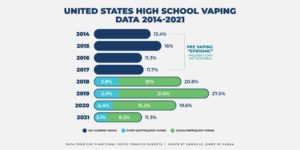
A study released by the U.S. Food and Drug Administration and the U.S. Centers for Disease Control and Prevention (CDC) found that youth use of e-cigarettes fell sharply in 2021, the second consecutive year of major declines, according to the government’s annual National Youth Tobacco Survey (NYTS). An estimated more than 2 million U.S. middle and high school students reported currently using e-cigarettes in 2021, with more than 8 in 10 of those youth using flavored e-cigarettes.
The study shows that an estimated 11.3 percent (1.72 million) of high school students and an estimated 2.8 percent (320,000) of middle school students reported current e-cigarette use, lower than the 19.6 percent (high school) reported in 2020 and substantially lower than the 27.5 percent reported in 2019 (high school), according to previous FDA statements. Middle school vaping fell to 2.8 percent this year from 4.7 percent in 2020—a 40.4 percent decline. Middle school past 30-day vaping in 2020 fell 55.2 percent from 2019.
The report, published in the CDC’s Morbidity and Mortality Weekly Report, was based on data from the 2021 NYTS, a cross-sectional, self-administered survey of U.S. middle (grades 6–8) and high (grades 9–12) school students. The study assessed current (used on one or more of the past 30 days) e-cigarette use; frequency of use; and use by device type, flavors and usual brand.

Among youth who currently used e-cigarettes, the study found the most commonly used e-cigarette device type was disposables (53.7 percent), followed by prefilled or refillable pods or cartridges (28.7 percent), and tanks or mod systems (9.0 percent). Some in the industry have pointed out that “for the record, past-30-day ever use was 7.6%. The real numbers are: Disposables: 4.1%, Pods or cartridges: 2.2%, Tanks or mod systems: 0.7%,” a vaping advocate (@phil_w888) tweeted.
The FDA and CDC are also being accused of using the data to further an anti-vaping agenda. The Consumer Advocates for Smoke-free Alternatives Association (CASAA) tweeted that “Past-month HS vaping declines dramatically–down 47% from 3.6 million to 1.72 million–with daily vaping down from 4.4% to around 3%. Yet the general public wouldn’t know that from the negative spin made by Public Health.”
Administered Jan. 18- May 21, 2021, thus NYTS was the first to be fully conducted during the Covid-19 pandemic. Data were collected using an online survey to allow eligible students to participate in the classroom, at home or in some other place to account for various school settings during this time. Prior to the pandemic, the survey was conducted in person, inside the school classroom. Because of the changes in the way the survey was conducted this year, the FDA claims results of the 2021 NYTS cannot be compared to findings from previous surveys.
Robin Koval, president and chief executive of Truth Initiative, a nonprofit anti-nicotine advocacy group, emphasized that the sharp drop in youth vaping may be attributable to pandemic restrictions that kept youth at home. “Kids were not in school, they were not seeing friends,” Koval said. There was no mention of the drop from 2019 numbers that were measured before the Covid-19 pandemic began.
“These data highlight the fact that flavored e-cigarettes are still extremely popular with kids. And we are equally disturbed by the quarter of high school students who use e-cigarettes and say they vape every single day,” said Mitch Zeller, director of the FDA’s Center for Tobacco Products. “The FDA continues to take action against those who sell or target e-cigarettes and e-liquids to kids, as seen just this year by the denial of more than one million premarket applications for flavored electronic nicotine delivery system products. It is critical that these products come off the market and out of the hands of our nation’s youth.”

